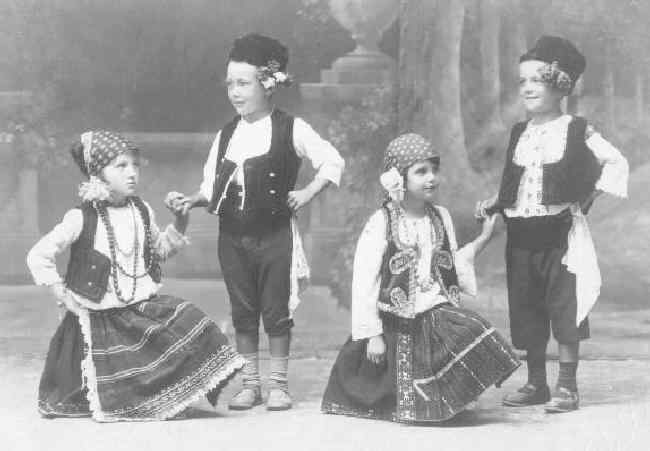
Ethnic or Folk Dancing Costumes: Gypsy Dance

Figure 1.--This portrait shows a pair of children who look to be doing Gypsey dance. This could be just another costumed portrait, but these children look to be dancing. We are not sure in what kind of venue these children would have perfirmed. The portrait is undated and unidentified. We would guess that it was taken about 1910. This may have been a Bulgarian portrait. The photographer appears to have been R. Liebich.
|
We know little about gypsy dance and music at this time. We do know that gypsey music has influenced some important Austrian and Hungarian composers. Gypsy dance has also been influential. The best known dance with Gypsey influence is flamenco. We have noted several images of European children in gypsey folk dress. These were not photogtaphs of gypsy childre, but rather other Europan children dressed up in novelty outfits. This seems to have been most common in Austria, Germany, and Hungary. Almost all the images we have noted are pre-World war I.
We do know that gypsy music has influenced some important Austrian and Hungarian composers. Pablo de Sarasate comes to mind with his beautiful "Zigeunerweisen" (Gypsy Airs). Also Johannes Brahms, who departed from his usual North-German compositions to write some stirring "Hungarian" walzes and of course, Franz Liszt, who listened to Gypsy music as a boy in Hungary and who proclaimed his Hungarian Rhapsodies to be authentic folk music, a mistake that later was corrected by Bela Bartok and Zoltan Kodaly who composed the real thing: Magyar-inspired melodies. Many other (lighter) composers used gypsy music in their operettas: Johann Strauss, Franz Léhar, Emmerich Kalman and Leo Fall. One of Strausses operettas was even called " Der Zigeunerbaron" (The Gypsy Baron), Léhar wrote one with the title "Zigeunerliebe" (Gypsy Love) and Kalman "Der Zigeunerprimas" (a primas is the first violinist in a Gypsy orchestra).
Dance
The most famous gypsy dances in the world are being performed in Andalucia, in the south of Spain. The Spanish gypsies have been most prominent in this type of dance, song and guitar music for centuries. I don't know much about gypsy dances in Southeastern Europe. The Gypsies possibly followed more or less the music and dances of the people in who's midst they were living. A Dutch reader writes "I remember a famous Romanian gypsy band as a boy, Georges Boulanger (in spite of his French name he was a real gypsy from Romania). There were others: Kovacs Lajos and Barnabas von Geczy in Hungary.
Gypsy Costume Photography
We have noted several images of European children in gypsy folk dress. These were not photogtaphs of gypsey childre, but rather other Europan children dressed up in novelyu outfits. This seems to have been most common in Austria, Germany, and Hungary. Almost all the images we have noted are pre-World war I. This becomes much less common after the War as along with the rise of Fascism, concepts of nationality and race become more hardened. Most of the images we have seen are simple costume portraits, but we have found some which deal with dance.
HBC

Navigate the Historic Boys' Clothing Web Site:
[Return to the Main ethnic dance page]
[Return to the Main Gypsy page]
[Introduction]
[Activities]
[Biographies]
[Chronologies]
[Style Index]
[Countries]
[Bibliographies]
[Contributions]
[FAQs]
[Glossaries]
[Satellite sites]
[Tools]
[Boys' Clothing Home]
Navigate the Historic Boys' Clothing Web chronological pages:
[The 1900s]
[The 1910s]
[The 1920s]
[The 1930s]
[Thw 1940s]
[The 1950s]
[The 1960s]
[The 1970s]
[The 1980s]
[The 1990s]
Navigate the Historic Boys' Clothing Web style pages:
[Kilts]
[Caps]
[Sailor hats]
[Lederhosen]
[Sailor hats]
Created: 10:27 PM 3/15/2005
Last updated: 5:53 AM 3/21/2005



